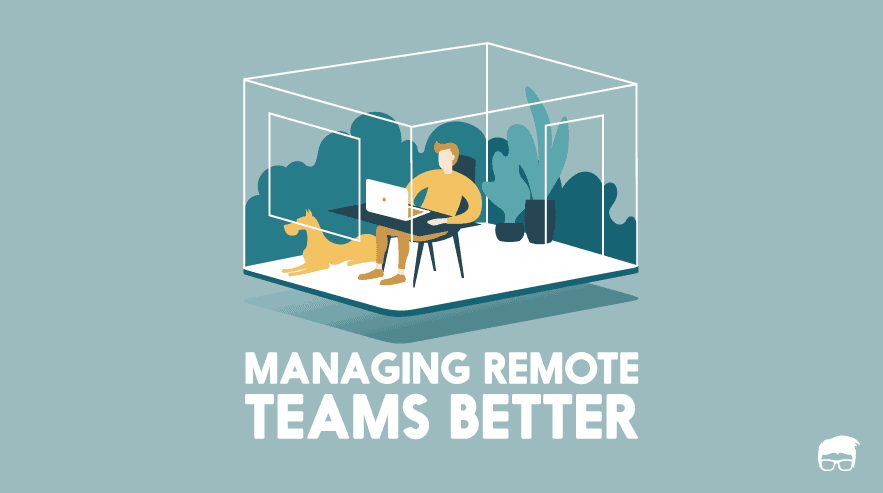In the past five years, remote work has grown by 44% —and it’s pretty easy to see why. But remote work isn’t a recent phenomenon that emerged only in the past few years. In fact, it has a rich history dating back to as early as the 1990s, as revealed by a report published by Mckinsey & Co. Remote teams have quietly existed and thrived long before they became a popular trend in the modern work landscape.
In this comprehensive guide, we’ll dig deep into the concept of remote teams – what they are, the different types that exist, the challenges and, most importantly, the numerous advantages they offer.
What Is A Remote Team?
A remote team is a group of people working together from different locations but in collaboration to reach the same goal. They often communicate and collaborate using digital tools and are often managed by one or more remote managers.
Remote teams can be geographically dispersed, meaning they work from different countries or cities. They can also be distributed, in which case the team works from various locations within one country.
Unlike traditional office setups, remote teams heavily rely on technology for seamless communication and collaboration. For example, they use project management tools for task management, video conferencing to stay connected with each other and cloud storage solutions for sharing files.
Today, several companies have embraced remote teams and are reaping the benefits. In fact, research shows that companies with remote teams reported 25% less employee turnover than their non-counterparts.
Types Of Remote Teams
Even though the concept of remote teams remains the same, not every remote team is the same. Different organisations have different needs, and therefore, there are several types of remote teams that exist in today’s corporate landscape.
- Fully remote teams: These refer to remote teams where all the members are geographically scattered and don’t come together at any point. This type of team often has members from multiple countries, cities, or even continents.
- Hybrid teams: A hybrid team includes a mix of both remote and on-site employees. It may be a combination of employees working in different locations or the same location but from different offices.
Importance Of Remote Teams
With digitisation, globalisation and constant technological advancements, remote teams have become an important part of the corporate landscape. Having a remote team can bring immense value in various ways, especially in certain scenarios such as:
- Geographical Limitations: With a remote team, organisations can overcome geographical limitations and build a team with members from across the world.
- Cost Savings: Remote teams enable organisations to save costs on infrastructure, office space, and other relocation expenses. Also, when it comes to recruiting talent, remote teams make it easier for businesses to find the right people without spending money on travel or relocation costs. Hiring Process
- Business Continuity: Remote teams are especially beneficial during unprecedented situations when people can’t come to the office. Natural disasters, extreme weather conditions, or health emergencies can disrupt the normal operations of an office-based workforce. In such cases, having a remote team enables business continuity as employees can continue working from their homes or any other safe location.
Advantages Of Remote Teams
No more long commutes, the freedom to work from anywhere, and a schedule that aligns with personal preferences — these are some of the top benefits of having a remote team.
- Greater Flexibility: Remote work offers the freedom to work from any location, allowing team members to create a customised work environment that suits their needs. Whether it’s working from home, a coffee shop, or a different country altogether, remote teams enjoy unparalleled flexibility.
- Better Productivity: According to a survey conducted by Stanford University professor Nicholas Bloom, it was found that 9% of remote workers reported being more efficient at home than in the office.
- Expanded Talent Pool: With remote teams, companies and businesses can hire top talent from virtually any corner of the world. Geographical location is no longer an issue, which also means recruiting candidates who bring in a diversity of skills and perspectives, further benefiting the organisation greatly.
- Cost Savings: Remote teams can often lead to significant cost savings for both companies and employees. Companies can reduce office space, utilities, and equipment expenses, while employees save on commuting costs and potentially even relocation expenses.
- Better Health: As per numerous studies, it has been found that employees tend to take good care of their health when they’re operating remotely. According to a survey conducted by Costo Cloud, 42% of remote workers ate healthier meals working from home than they did in an office-based environment.
Challenges of Remote Teams
While offering numerous advantages, remote work also comes with its fair share of roadblocks and challenges:
- Communication and Collaboration: Remote teams rely heavily on virtual communication tools, which can sometimes result in miscommunication or difficulties in conveying information effectively. For example, a small fault in the internet connection or a few seconds of delay can cause huge misunderstandings.
- Building Trust: Without regular face-to-face interactions, building trust among team members can be quite challenging. Establishing a sense of camaraderie and fostering a strong team culture requires intentional effort and creative virtual team-building activities.
- Work-Life Balance Boundaries: Remote work offers flexibility but can also blur the boundaries between work and personal life. Remote team members may struggle to establish clear boundaries, leading to potential burnout or difficulty in switching off from work.
- Managing Different Time Zones: Working remotely could also mean collaborating with individuals located in various time zones. Coordinating meetings, ensuring timely communication, and accommodating different working hours could come up as a logistical challenge.
- Potential for Social Isolation: Working remotely can often cause feelings of social isolation and disconnection. Without regular face-to-face interactions, team members may miss out on casual office conversations and the spontaneous exchange of ideas.
Case Examples of Successful Remote Teams
Creating a productive remote team doesn’t happen by accident. It requires planning and execution, along with the right mix of people, processes, and technology.
And surprisingly, there are some remarkable companies out there that have managed to pull off the remote team magic. Let’s take a look at some inspiring examples:
Buffer – Striking The Perfect Balance Between Productivity And Burnout
According to research conducted by Buffer, 18% of remote employees struggle with being able to “unplug” from work.
To address this issue, Buffer came up with a clever solution using Slack, their communication tool of choice. They established what they call the “10 Slack Agreements,” a set of guidelines aimed at helping their employees set clear expectations and strike a healthy balance between productivity and avoiding burnout.
The fact that Buffer recognised the need for such agreements highlights the importance of providing tools to employees and helping them understand how those tools should be used.
It’s not just about having the technology; it’s about utilising it in a way that promotes a healthy work-life balance and prevents the feeling of being constantly tethered to work.
HotJar – Team Building Done Right
With over 100 employees across a distributed team, Hotjar believes in being “very intentional and proactive about building personal connections.”
So, how do they make it happen?
Well, the answer is pretty simple: virtual team-building activities.
Now, conducting team-building activities through video conferencing software might take a little getting used to, but Hotjar sure knows how to make the best of it. And here’s how they do it:
- “10 things about you” sessions—where workers tell fun facts and weird stories about themselves to spark conversations during onboarding.
- Coffee sessions: 15-minute meetings where workers run quick presentations about how they recently learned something new that might benefit the team (“Stretches I do at my desk” or “How I organise my emails”).
- Wednesday bonfires: Company-wide meetings where workers catch each other up on interesting topics or discuss ways to improve personal growth.
Best Practices For Remote Teams
To ensure the remote team is running smoothly and efficiently, it’s important to set up some solid operational processes. Here are a few best practices to consider:
Establish Clear Expectations
34% of remote workers worldwide believe that transparency from leadership fosters a strong sense of connection at work. And a big part of transparency is establishing clear rules and regulations for the team members.
When it comes to managing remote teams, setting boundaries and expectations is crucial. Team members must be aware of their roles and responsibilities, work hours, deadlines, communication protocols, etc.
This would mean communicating:
- Company Culture: Clarifying the organisation’s mission and core values to ensure everyone is on the same page.
- Evaluation Criteria: Setting measurable goals, objectives, and deadlines to keep team members accountable.
- Tools & Technology: Providing necessary resources for remote workers to do their job efficiently. For example, video conferencing software, project management tools, etc.
- Remote Work Procedures: Establishing the processes for how tasks should be completed, and communication should take place.
- Project Guidelines: Clearly communicate the guidelines for projects. Share the objectives, milestones, and deadlines so that everyone is on the same page and working towards a common goal.
- Communication Style Guide: Establish expectations for how team members should communicate with each other and clients.
- Workload and Availability Expectations: Define the expected working hours, availability for collaboration, and how the company measures productivity. This clarity helps team members plan their workday efficiently and enables effective coordination.
Set Regular Check-Ins
When the team is all in the same office, it’s easy to keep everyone updated and touch base regularly. But this can be done in a remote setup as well.
For instance, managers can kick things off with a daily meeting that lasts around 15-20 minutes. Take turns going around the virtual circle, giving each team member a chance to share their plans for the day, any challenges they’re facing, and what kind of support they may need from their colleagues.
Invest In The Right Remote Team Management Tools
When it comes to managing a remote team, having everything the manager and employees need in one place can truly work wonders for the team’s work culture. That’s where remote team management software comes in handy. These tools help managers organise tasks, track deadlines, and assign jobs quickly and easily. They also provide the means for workers to communicate with each other in real time, making it easier for them to collaborate on projects.
Provide Opportunities To Socialise
According to a survey conducted by Buffer, 20% of remote workers experience a heightened sense of loneliness, and another 20% find it tough to collaborate and communicate.

So, it’s extremely important to encourage social interaction in remote teams. This could mean planning and arranging virtual hangouts, morning coffee standups, joint brainstorming sessions, online lunch and learns, and team-building games.
Remote Team Management Tips
Remote team management can come with its own unique set of challenges, but with the right approach, managers can maximise the productivity of their virtual team. Here are a few remote team management tips that can make a significant difference:
- Set clear goals and expectations for each member of the team.
- Establish regular check-ins to provide feedback and address any concerns.
- Utilise project management tools to track progress and deadlines.
- Use employee remote monitoring software as a tool for collaboration and improvement rather than solely for surveillance.
- Make sure to encourage open and transparent communication among team members.
- Foster a sense of community through virtual team-building activities.
- Provide opportunities for professional development and growth.
- Trust team members to deliver quality work and avoid micromanaging.
- Promote work-life balance by encouraging breaks and respecting personal boundaries.
- Create a supportive and inclusive team culture, even in a virtual environment.
- Celebrate achievements and recognise individual and team contributions.
An ardent reader, full-time writer and a lover of all things purple. Riya is an entrepreneurial spirit, making her way in the start-up industry through her expressive writing. When not working, you can find her jamming to music, watching period films, eating sushi, or petting cats.









